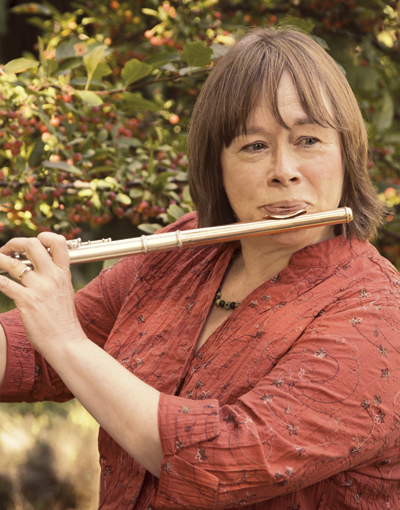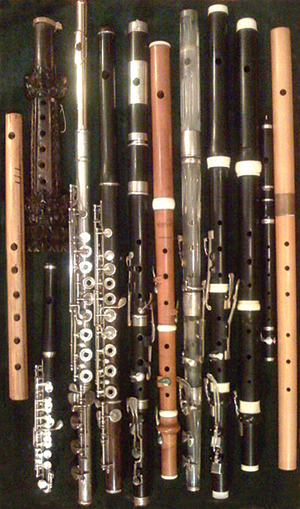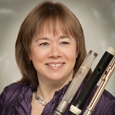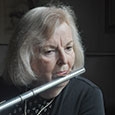 I first heard Wendy Rolfe perform at the Texas Flute Society in Denton, Texas in May 2003. We, along with Robert Dick and Debbie Ragsdale, were judges for the Myrna Brown Competition. In addition to our judging duties, we each gave a masterclass and performed a recital. Rolfe’s recital was unusual because every composition on her program was played on the appropriate historical instrument. As she so adeptly and artistically switched from one flute to the next, the music came alive in a fresh way. The audience responded enthusiastically and more than one of us came away with the desire to purchase an historical instrument.
I first heard Wendy Rolfe perform at the Texas Flute Society in Denton, Texas in May 2003. We, along with Robert Dick and Debbie Ragsdale, were judges for the Myrna Brown Competition. In addition to our judging duties, we each gave a masterclass and performed a recital. Rolfe’s recital was unusual because every composition on her program was played on the appropriate historical instrument. As she so adeptly and artistically switched from one flute to the next, the music came alive in a fresh way. The audience responded enthusiastically and more than one of us came away with the desire to purchase an historical instrument.
Wendy Rolfe is Professor of Flute at the Berklee College of Music in Boston, where she also performs on historical flutes with the Handel and Haydn Society and Boston Baroque. She frequently tours Brazil, and this spring, was a Fulbright Senior Specialist in Quito, Ecuador.
How did you get started on Baroque flute?
I have always loved the sounds of flutes from around the world, from the first time I heard a those in a Javanese Gamelan in junior high school to Japanese Gagaku court music. When I was a senior in high school, I played in a Baroque chamber music ensemble in a nearby town, directed by Robert Koff, one of the founding violinists of the Juilliard String Quartet.
Koff also introduced me to Baroque performance practice through Quantz’s On Playing the Flute and other sources. During a first year January Winter Term break at Oberlin, I went to Holland to study Baroque repertoire on modern flute with Frans Brüggen and recorder with Kees Boeke in Amsterdam. Brüggen was eloquent on the importance of playing the repertoire on traverso, so I took a Baroque flute intro class at the Museum of Fine Arts in Boston, taught by Nancy Roth. Bob Willoughby had devoted a sabbatical year to studying traverso, so I was able to continue with him at Oberlin.
A rewarding aspect of playing traverso is that the instrument teaches us a lot about the music. Unlike the more homogenized sound of the notes on a modern Boehm flute, each note on a Baroque flute has its own quality. As Ardall Powell writes in his book on flutist and flute-maker Tromlitz, the unique color of each note was prized by players and listeners. Composers would choose to write in different keys; they might use the key of D Major if they wanted to project a strong, outgoing emotion or G minor for a sweeter or more contemplative mood.
Since the traverso is built in the key of D, the note F# is stronger than F natural, and Bn has a different character than Bb. So if a flutist plays a movement in G minor, the instrument tells the player to moderate the air on the Bb and F natural. These notes are much more muted and will crack if the flutist uses as much air as on B natural and F#. This gives the music a sweeter and more introverted quality. When a flutist plays the J.S. Bach Sonata in G minor or the Allegros from the E minor on the traverso, the colors of the special notes in each key are much more evident than when played on a modern flute.
How do you stay in shape on so many different flutes?
Each flute I play, including a Baroque traverso, Classical 6 or 8-key, Romantic 8 or more key, Baroque and Classical piccolos, and my modern instrument, has different fingerings and tunings. Even my 1876 wooden Rudall Carte Boehm system’s intonation is very different from a modern flute and piccolo, so it is a continual challenge.
Intonation is always paramount, and 99.9% of the time I practice with a tuner. The tuner can also be used as a drone for work on intervals. When playing earlier music, there are different tuning systems, so not all the intervals are the same as in equal temperament. I begin practicing with the first pages of the Marcel Moyse half-step descending and ascending long tones from L’Art de la Sonorité. Then, I often go to the exercise on page 15, choosing a difficult note that may either be awkward to finger or have intonation challenges. For instance, the G# on traverso is unstable, so practicing all possible intervals for that note helps to iron out difficulties.
I often play through either the Taffanel & Gaubert 17 Big Daily Exercises #4 (with adjustments for the ranges) or #1 and #2 on traverso and Classical flutes. Other days, I may substitute Mathieu-André Reichert’s Daily Exercises #1 and #2, so that even on the flutes for which playing in advanced key signatures is sheer torture, I am able to get around the entire circle of fifths.
For tone, I sing and play to stay open. Sheryl Cohen’s book, The Rampal School, has excellent descriptions of how to practice Hu and Ku which do wonders in opening up the torso, chest, and throat. In addition, I studied the Alexander Technique for four years, and that training helps me to avoid injury by staying flexible and keeping the muscles extended. I frequently give masterclasses here and in Latin America, and this training enables me to quickly spot and address posture problems in students.
 How does the shape of the embouchure hole on the Baroque flute affect how you use your air?
How does the shape of the embouchure hole on the Baroque flute affect how you use your air?
The embouchure holes on the older flutes tend to be a lot smaller, so the player’s airstream must be narrower. Lois Schaefer used to say that her teacher, Georges Laurent former principal flute Boston Symphony, told her in his French accent to peench the lips in order to focus the air. I think about projecting the sound through finding the resonance of each note in the instrument. If I think of the sound traveling around in all of the empty spaces in my head, of my throat and chest being cavernous, and of expanding rather than pushing the air stream, the instrument responds like a good friend.
What about tonguing?
One of the basic references Baroque flutists use to learn articulation is J.J. Quantz’s, On Playing the Flute. In playing four sixteenth notes, on the first (strong) and third notes we use the ti or ri syllables and on the lighter notes, the second and fourth, di. There are a variety of syllables that may be used to play different kinds of intervals depending upon whether the interval is large or small. Baroque flutists also use a various syllables to express a variety of moods. A simple example is to think of using tu on the modern flute to play livelier music and du to play more lyrical passages. Most students have a limited number of syllables they use while playing.
Betty Bang Mather’s excellent volume on J.S. Bach’s Partita in A Minor for solo flute (Falls House Press) includes examples of articulations that address many of its phrasing challenges.
The did’ll tonguing that is common in Baroque treatises is one that I have not spent the necessary time to master. I have always been able to double-tongue pretty fast, so I don’t notice a real difference in response among the flutes. I remember Rampal once demonstrated in a masterclass how important a fast air speed is to successful double-tonguing, so I encourage my students to think of expanding their rib cages and pulling the air down to get their tongues moving.
What about vibrato?
It is good practice to play without vibrato and add it as an ornament on certain notes to bring out a dissonance. The flattement, or finger vibrato that Jacques Hotteterre describes, is much easier on a one-key flute. On a modern flute, the keys actually get in the way. The flattement is useful in making a mezza di voce or swell on a long note. Vibrato should be used rarely in Baroque and Classical music, and even more rarely on final notes of phrases.
 How does the distance between the holes on Baroque flutes affect hand position?
How does the distance between the holes on Baroque flutes affect hand position?
The distance between the holes varies among flutes. With some flutes, one has to be very careful not to strain the hand. Because I have small hands, my position is quite unorthodox. I turn the headjoint in, which rotates the body of the flute out, so that my left hand fingers are much closer to the holes. I also keep the fingers a bit above the holes; if they are too close, the intonation on certain notes can be affected. Sometimes, not keeping my right index finger right over the f hole, but moving it slightly laterally can ease strain. When playing, I think of getting length all the way from the shoulder, with a long elbow and loose wrist, and with a wide palm. I don’t play some flutes because I know they will strain my right hand as the d hole is quite far away from the e hole. It is a good idea to start out playing a traverso a little bit at a time to avoid strain.
What books did you read when you were beginning to learn the Baroque flute?
I read Quantz and Hotteterre. Often, how I learned was by letting the instruments teach me what would work and what would not. I listened to many traverso players and continue to learn a great deal from working with colleagues, such as Greer Ellison, Chris Krueger, Sandra Miller and Anne Briggs. I also learn from listening to harpsichordists, violinists, and singers. Listening to viola da gamba players playing bass lines helps with note lengths and the stresses of each beat. Reading the treatises by C.P.E. Bach, Leopold Mozart, and other non-flutists is helpful, too.
Tulou is very useful for fingerings for later keyed flutes, as are Drouet and Nicholson (thanks to Jan Boland for publishing reprints or facsimiles of these). The keyed flutes are different animals, in many ways. I just had the pleasure of playing Haydn and Mendelssohn with my long-time friend and colleague, Sandra Miller. For the Haydn, I used my 8-key copy of an August Grenser flute (c. 1790, by Martin Wenner) and for the Mendelssohn, a borrowed copy of a Koch flute (c. 1820, by Boaz Berney). The key setup on each is almost the same, but the actual keys are different sizes and lengths, and the intonation on each, is of course, unique.
What composers do you enjoy the most when playing Baroque flute?
Whichever composer I am playing at the moment is my favorite. I love to play Bach, Handel, Telemann, Vivaldi. French Baroque repertoire (Rameau, Couperin, Hotteterre) is actually much more satisfying to play on the traverso because we can actually play the ornaments much more effectively without the keys in the way. I have learned a tremendous amount about the music by playing with Baroque dancers, notably the New York Baroque Dance Company. Understanding the language and rhythm of the dance gestures gave me a lot of insights.
Do you have to do anything special to keep the flute from not cracking?
These flutes require some extra care. When I travel, I put the flute in a sealed plastic bag, sometimes with a small, moist sponge included. As flute maker Rod Cameron once explained, the inside of the bore (tube) is absorbing condensation while we play, so it is expanding. The outside of the tube is not expanding at the same rate, so there is tremendous outward pressure. Sometimes, I moisten the outside of the headjoint to equalize the pressure. I oil my flutes pretty regularly with almond oil. There are good explanations by flute makers on the Internet on how to do this.
What led you to study the flute?
I always wanted to play the piccolo, but was told I must begin with the flute. I grew up in Lincoln, Massachusetts where we had the opportunity to study with music teachers at our elementary school on weekends. I began flute lessons when I was eight. My first teacher, Vincent Cavally, taught me solfeggio along with my beginning studies. I still have my first Rubank Elementary Method with some of the solfeggio syllables written in above the notes. When he moved back to New York City, I studied with Jan Smith who was an excellent teacher and stressed the basics with me. Years later I saw a photo of myself at age nine or ten and realized that I had played with a big smiley embouchure, my right thumb out of position, and so many other bad habits. By the time Smith did her magic with me, I had such a good hand position that switching to an open hole flute a few years later was a piece of cake.
One of my favorite tunes was the duet “Little Brown Jug” in the Everybody’s Favorite Flute Series. I have warm memories of my grandfather playing it on his violin with me. We played a lot of chamber music at home, and I remember sightreading the Brandenburg Concerto #4 with Smith at one of these musicales. Playing Telemann, Vivaldi, and Handel Trio Sonatas and the Bach Double Violin Concerto at an early age fostered my love of chamber music.
When I was a sophomore in high school, I decided that I wanted to be a musician. I started to practice two to three hours a day. Smith moved to St. Louis where she became Assistant Principal Flute of the St. Louis Symphony, a position she held for 35 years. My next teacher was Bill Grass. He worked with me on the French repertoire. As I was preparing for college auditions, I studied with Lois Schaefer, solo piccolo of the Boston Symphony. Schaefer was fantastic at getting my sound focused, yet open. She said, “think of a pear-shaped tone, with the stem of the pear coming out between your lips, and the large part of the pear in your throat.”
Why did you decide to study at Oberlin?
When the time came to choose a college, I realized that I wanted a broader education than was available at a conservatory. Oberlin offered both: a conservatory and a college. Robert Koff, my high school chamber music teacher, was a graduate of Oberlin and recommended the school to me. For my Oberlin audition, I prepared the J.S. Bach E-Flat Sonata, the Quantz G Major Concerto, and the Poulenc Sonata. As part of an independent study project at my high school, I presented a recital performing these pieces in preparation for my audition.
I met Robert Willoughby (we are now allowed to call him Bob) at my audition. When I played the second movement of the Bach Sonata, the Siciliano, he sat down and accompanied me on the piano. He is a consummate musician. With Willoughby we studied Baroque music on the traverso, and avant-garde and standard flute repertoire on the modern Boehm flute. He taught us to think for ourselves and to have good reasons for interpretive choices. Although I had played in youth orchestras since the age of eight, I decided in my senior year that I would not pursue an orchestral career at that time. Instead I chose to focus on the outside edges of the repertoire, mainly Baroque and contemporary music.
Willoughby encouraged his students to form close relationships with each other. Greer Ellison and I began performing together during our Oberlin days. We went on to create an ensemble A Flute for All Seasons and had the honor of performing together at Willoughby’s 90th Birthday Tribute at Oberlin in October 2011 (see Flute Talk, December 2011). Now, I stress with my students at Berklee that their fellow flutists will be among their most important colleagues in their future careers. Upon graduation I moved to New York City to study contemporary music with Harvey Sollberger. He thought I should go to school, so I would meet other musicians in the area. I auditioned for the Manhattan School of Music that September and was Sollberger’s first flute student there.
What came next?
After finishing my master’s degree, colleagues and I founded the Odyssey Chamber Players. The goal was to introduce audiences to contemporary music by programming it with standard repertoire. We developed a residency in Brooklyn, a concert series in Manhattan, and briefly toured for Columbia Artists. Through Odyssey, I learned a lot about the business of music and became versed in writing government, foundation and corporate grants.
After a couple of years, I went back to Manhattan to work with Sollberger on my doctorate, as it was clear that it was necessary for a university teaching position. I taught in community music schools, and, as part of my doctoral fellowship, taught at the Manhattan School of Music Prep Division for about six years and gave masterclasses, and a lecture-recital, Journey Through Music History with the Flute, featuring flutes from the Renaissance, Baroque, Classical (including my 1818 crystal Claude Laurent flute), and contemporary periods.
I developed several sources of income in those years and learned about the business of having a career as a musician. It is much more difficult now to pursue a career in music. The number of orchestras is shrinking, and there are a finite number of university teaching posts. When I go to conventions, it is amazing to see the many creative ways flutists craft careers with skills in music technology, music therapy, and music education.
What are your current projects?
This fall my Oberlin classmate and long-time piano collaborator, Deborah DeWolf Emery, and I started to record our CD celebrating music written by women composers. As an evolution of my lecture-recital, Journey Through Music History with the Flute, I have been incorporating more and more pieces written by women into the program and performing on flutes from the eras in which they were written. Another project I have undertaken with several Berklee alumni and students is the founding of an independent group, the World Flutes Ensemble. With four flutes, guitar, bass and hand percussion, we are creating new repertoire that includes original compositions and arrangements of music from Argentina, Brazil, Japan, Turkey, South Africa, Native American, plus jazz and funk.
My long-term goals include focusing on human rights work through music education, especially in developing countries. The musicians who keep returning to the International Flute Festival in Quito (see sidebar), all volunteer time and resources to support the work of colleagues in Ecuador and the flute traditions founded by flutist Maestro Luciano Carrera.
Oddly enough, I have kind of slid into playing quite a bit of piccolo. This includes modern piccolo in the Cape Cod Symphony. Plus, I am playing Baroque 1-key and Classical 5/6 key piccolos. This spring, I will be going back to play the latter with Toronto’s Tafelmusik Baroque Orchestra, and with Mercury, in Houston, Texas.
What advice do you have for flutists who want to play the traverso?
The best advice is to listen to traverso players, Baroque violinists, and singers. Be patient and let the instrument teach you about the music you are playing. You should also read Quantz, Hotteterre, Carl Philipp Emanuel Bach, and more. The late flutist, David Hart (in honor of whom the NFA David Hart Fund was created) said when he first began studying the traverso, he sat by a lake in Belgium and played long tones for a month. Add a tuner, and you are all set.
* * * *
Flute Festival in Quito
By Wendy Rolfe
Eighty flutists from around the globe came together for a week in June for the Twenty-Second Festival Internacional de Flautistas en Centro del Mundo 2012. Held in Quito, Ecuador, it was also an homage to the career of Festival Director, Luciano Carrera. Concerts, rehearsals, and masterclasses were hosted by Quito’s La Casa de la Musica concert hall and Dr. Gustavo Lovato, who does important work in music education in Ecuador. Performances were also presented at schools and universities all over the city. Each day there were masterclasses on all instruments, Coral de Flautas (Flute Choir) rehearsals, and two to three concerts.
Carrera’s remarkable fifty years as a member of the flute section of the Orquesta Sinfonica Nacional of Ecuador were honored at the Gala Friday night concert with the Orquesta. Fittingly, he was featured that night in an outstanding performance of “Joaquim” Quantz’s Concerto in G Major. After almost fifty years of teaching, students of his first students are now teaching some of the youngest members of the Coral de Flautas. Carrera was visibly moved when speaking about Festival artist, Nury Ulate Solis, one of his first students when he was pursuing his own flute studies in Costa Rica. Another of his former students, Orquesta Sinfonica piccoloist Eugenia Aizaga, showed off her Suzuki Flute Ensemble at one of the opening concerts. Others are on the faculty at the Fondacion Orquesta Sinfonica Juvenil de Ecuador.
While it is officially a flute festival, there were many fantastic pianists and string players in attendance who were an integral part of the event. The members of the Colombian Ensamble Conclave performed arrangements of national tunes, and included Felipe Garcia, flute professor at Universidad Nacional in Bogota, with clarinet and stringed instruments including guitar, tiplé, bass, charanga, plus percussion.
One Ecuadorean quena flute was pitted against eighty flutists and native percussion in the “Coral Internacional de Flautas en el Centro del Mundo.” This may not seem like a fair contest, but Orquesta Sinfonica flutist and Andean flute specialist Luis Fernando Carrera brought down the house soloing on the quena in his arrangements of popular national tunes. Led by Festival Co-Director Angeleita Floyd, the Coral concert closed a week of fourteen concerts. The Coral’s repertoire ranged from Mozart’s Divertimento in D, K. 136, to Ketelby’s “In a Persian Market,” to numerous Latin American favorites. Decked out in sunglasses, the members of the Coral, who ranged in age from seven to seventy, delighted their audience with “Alley Cat”.







